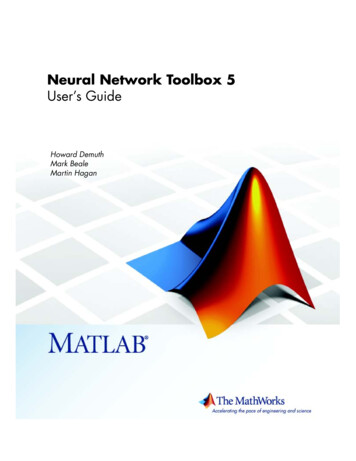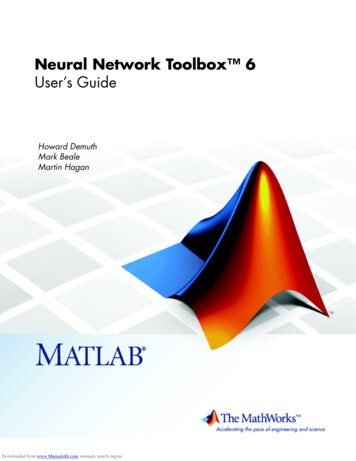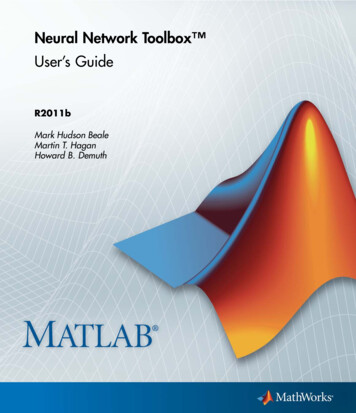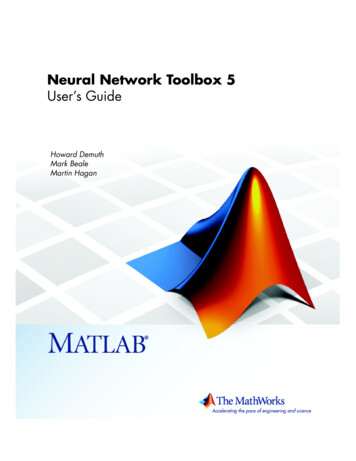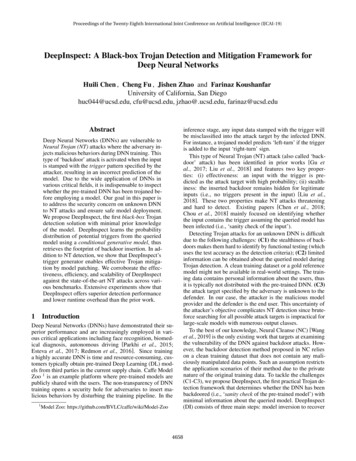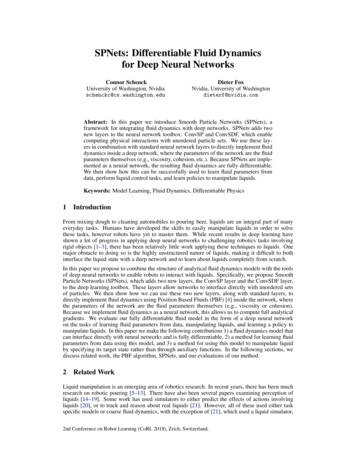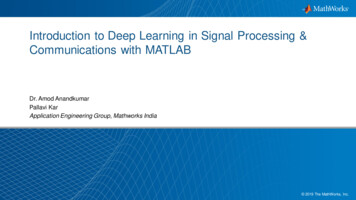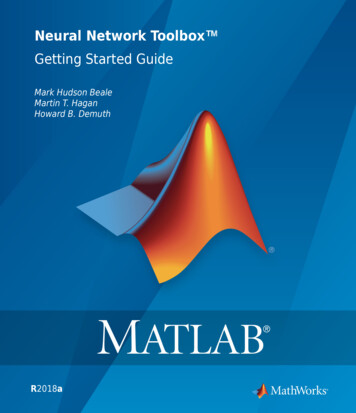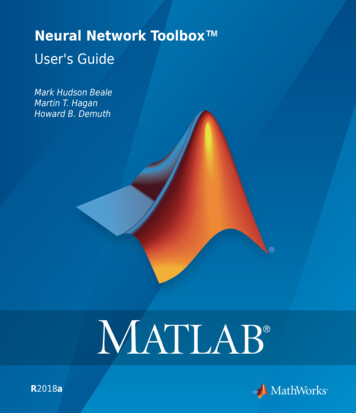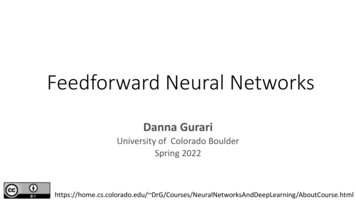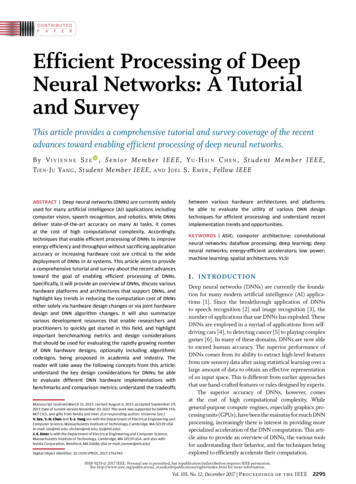
Transcription
Efficient Processing of DeepNeural Networks: A Tutorialand SurveyThis article provides a comprehensive tutorial and survey coverage of the recentadvances toward enabling efficient processing of deep neural networks.B y V i v i e n n e S z e , S e n i o r M e m b e r I E E E , Y u -H s i n C h e n , S t u d e n t M e m b e r I E E E ,Ti e n -J u Ya ng , Student Member IEEE, a n d J oe l S. E m e r , Fellow IEEEABSTRACT Deep neural networks (DNNs) are currently widelyused for many artificial intelligence (AI) applications includingcomputer vision, speech recognition, and robotics. While DNNsdeliver state-of-the-art accuracy on many AI tasks, it comesat the cost of high computational complexity. Accordingly,techniques that enable efficient processing of DNNs to improveenergy efficiency and throughput without sacrificing applicationaccuracy or increasing hardware cost are critical to the widedeployment of DNNs in AI systems. This article aims to providea comprehensive tutorial and survey about the recent advancestoward the goal of enabling efficient processing of DNNs.Specifically, it will provide an overview of DNNs, discuss varioushardware platforms and architectures that support DNNs, andhighlight key trends in reducing the computation cost of DNNseither solely via hardware design changes or via joint hardwaredesign and DNN algorithm changes. It will also summarizevarious development resources that enable researchers andpractitioners to quickly get started in this field, and highlightimportant benchmarking metrics and design considerationsthat should be used for evaluating the rapidly growing numberof DNN hardware designs, optionally including algorithmiccodesigns, being proposed in academia and industry. Thereader will take away the following concepts from this article:understand the key design considerations for DNNs; be ableto evaluate different DNN hardware implementations withbenchmarks and comparison metrics; understand the tradeoffsManuscript received March 15, 2017; revised August 6, 2017; accepted September 29,2017. Date of current version N ovember 20, 2017. This work was supported by DARPA YFA,MIT CICS, and gifts from Nvidia and Intel. (Corresponding author: Vivienne Sze.)V. Sze, Y.-H. Chen and T.-J. Yang are with the Department of Electrical Engineering andComputer Science, Massachusetts Institute of Technology, Cambridge, MA 02139 USA(e-mail: sze@mit.edu; yhchen@mit.edu; tjy@mit.edu).J. S. Emer is with the Department of Electrical Engineering and Computer Science,Massachusetts Institute of Technology, Cambridge, MA 02139 USA, and also with Nvidia Corporation, Westford, MA 01886 USA (e-mail: jsemer@mit.edu).Digital Object Identifier: 10.1109/JPROC.2017.2761740between various hardware architectures and platforms;be able to evaluate the utility of various DNN designtechniques for efficient processing; and understand recentimplementation trends and opportunities.KEYWORDS ASIC; computer architecture; convolutionalneural networks; dataflow processing; deep learning; deepneural networks; energy-efficient accelerators; low power;machine learning; spatial architectures; VLSII. I N T RODUC T IONDeep neural networks (DNNs) are currently the foundation for many modern artificial intelligence (AI) applications [1]. Since the breakthrough application of DNNsto speech recognition [2] and image recognition [3], thenumber of applications that use DNNs has exploded. TheseDNNs are employed in a myriad of applications from selfdriving cars [4], to detecting cancer [5] to playing complexgames [6]. In many of these domains, DNNs are now ableto exceed human accuracy. The superior performance ofDNNs comes from its ability to extract high-level featuresfrom raw sensory data after using statistical learning over alarge amount of data to obtain an effective representationof an input space. This is different from earlier approachesthat use hand-crafted features or rules designed by experts.The superior accuracy of DNNs, however, comesat the cost of high computational complexity. While general-purpose compute engines, especially graphics processing units (GPUs), have been the mainstay for much DNNprocessing, increasingly there is interest in providing morespecialized acceleration of the DNN computation. This article aims to provide an overview of DNNs, the various toolsfor understanding their behavior, and the techniques beingexplored to efficiently accelerate their computation.0018-9219 2017 IEEE. Personal use is permitted, but republication/redistribution requires IEEE permission.See http://www.ieee.org/publications standards/publications/rights/index.html for more information.Vol. 105, No. 12, December 2017 Proceedings of the IEEE2295
Sze et al . : Ef ficient Processing of Deep Neural Net work s: A Tutorial and Sur veyThis paper is organized as follows. Section II provides background on the context of whyDNNs are important, their history and applications. Section III gives an overview of the basic componentsof DNNs and popular DNN models currently in use. Section IV describes the various resources used forDNN research and development. Section V describes the various hardware platformsused to process DNNs and the various optimizationsused to improve throughput and energy efficiencywithout impacting application accuracy (i.e., producebitwise identical results). Section VI discusses how mixed-signal circuits and newmemory technologies can be used for near-data processing to address the expensive data movement that dominates throughput and energy consumption of DNNs. Section VII describes various joint algorithm and hardware optimizations that can be performed on DNNs toimprove both throughput and energy efficiency whiletrying to minimize impact on accuracy. Section VIII describes the key metrics that should beconsidered when comparing various DNN designs.II. BACKGROU N D ON DN NSIn this section, we describe the position of DNNs in the context of AI in general and some of the concepts that motivatedits development. We will also present a brief chronology ofthe major steps in its history, and some current domains towhich it is being applied.A. Artificial Intelligence and DNNsDNNs, also referred to as deep learning, are a part ofthe broad field of AI, which is the science and engineering of creating intelligent machines that have the ability toachieve goals like humans do, according to John McCarthy,the computer scientist who coined the term in the 1950s.The relationship of deep learning to the whole of artificialintelligence is illustrated in Fig. 1.Fig. 1. Deep learning in the context of artificial intelligence.Within AI is a large subfield called machine learning, whichwas defined in 1959 by Arthur Samuel as the field of study thatgives computers the ability to learn without being explicitlyprogrammed. That means a single program, once created, willbe able to learn how to do some intelligent activities outsidethe notion of programming. This is in contrast to purpose-builtprograms whose behavior is defined by hand-crafted heuristicsthat explicitly and statically define their behavior.The advantage of an effective machine learning algorithm is clear. Instead of the laborious and hit-or-missapproach of creating a distinct, custom program to solveeach individual problem in a domain, the single machinelearning algorithm simply needs to learn, via a processescalled training, to handle each new problem.Within the machine learning field, there is an area that isoften referred to as brain-inspired computation. Since the brainis currently the best “machine” we know for learning and solving problems, it is a natural place to look for a machine learningapproach. Therefore, a brain-inspired computation is a programor algorithm that takes some aspects of its basic form or functionality from the way the brain works. This is in contrast toattempts to create a brain, but rather the program aims to emulate some aspects of how we understand the brain to operate.Although scientists are still exploring the details of howthe brain works, it is generally believed that the main computational element of the brain is the neuron. There areapproximately 86 billion neurons in the average humanbrain. The neurons themselves are connected together witha number of elements entering them called dendrites and anelement leaving them called an axon as shown in Fig. 2. Theneuron accepts the signals entering it via the dendrites, performs a computation on those signals, and generates a signal on the axon. These input and output signals are referredto as activations. The axon of one neuron branches out andis connected to the dendrites of many other neurons. Theconnections between a branch of the axon and a dendriteis called a synapse. There are estimated to be 10 14 to 10 15 synapses in the average human brain.A key characteristic of the synapse is that it can scalethe signal ( x i ) crossing it as shown in Fig. 2. That scalingFig. 2. Connections to a neuron in the brain. xi , wi , f( · ) , and b arethe activations, weights, nonlinear function, and bias, respectively.(Figure adopted from [7].)2296 Proceedings of the IEEE Vol. 105, No. 12, December 2017
Sze et al . : Ef ficient Processing of Deep Neural Net work s: A Tutorial and Sur veyfactor can be referred to as a weight ( w i ), and the way thebrain is believed to learn is through changes to the weightsassociated with the synapses. Thus, different weights resultin different responses to an input. Note that learning is theadjustment of the weights in response to a learning stimulus, while the organization (what might be thought of as theprogram) of the brain does not change. This characteristicmakes the brain an excellent inspiration for a machinelearning-style algorithm.Within the brain-inspired computing paradigm there isa subarea called spiking computing. In this subarea, inspiration is taken from the fact that the communication on thedendrites and axons are spike-like pulses and that the information being conveyed is not just based on a spike’s amplitude. Instead, it also depends on the time the pulse arrivesand that the computation that happens in the neuron is afunction of not just a single value but the width of pulse andthe timing relationship between different pulses. An example of a project that was inspired by the spiking of the brainis the IBM TrueNorth [8]. In contrast to spiking computing,another subarea of brain-inspired computing is called neural networks, which is the focus of this article.1B. Neural Networks and DNNsNeural networks take their inspiration from the notionthat a neuron’s computation involves a weighted sum of theinput values. These weighted sums correspond to the valuescaling performed by the synapses and the combining ofthose values in the neuron. Furthermore, the neuron doesnot just output that weighted sum, since the computationassociated with a cascade of neurons would then be a simplelinear algebra operation. Instead there is a functional operation within the neuron that is performed on the combinedinputs. This operation appears to be a nonlinear functionthat causes a neuron to generate an output only if the inputscross some threshold. Thus by analogy, neural networksapply a nonlinear function to the weighted sum of the inputvalues. We look at what some of those nonlinear functionsare in Section III-A1.Fig. 3(a) shows a diagrammatic picture of a computational neural network. The neurons in the input layerreceive some values and propagate them to the neurons inthe middle layer of the network, which is also frequentlycalled a “hidden layer.” The weighted sums from one ormore hidden layers are ultimately propagated to the outputlayer, which presents the final outputs of the network to theuser. To align brain-inspired terminology with neural networks, the outputs of the neurons are often referred to asactivations, and the synapses are often referred to as weightsas shown in Fig. 3(a). We will use the activation/weightnomenclature in this article.1Note: Recent work using TrueNorth in a stylized fashion allows it tobe used to compute reduced precision neural networks [9]. These types ofneural networks are discussed in Section VII-A.Fig. 3. Simple neural network example and terminology. (Figureadopted from [7].) (a) Neurons and synapses. (b) Compute weightedsum for each layer.Fig. 3(b) shows an example of the computation ateach layer: y j f W(i 1 ij x i b) , where W ij , x i and y j are the weights, input activations, and output activations,respectively, and f( ) is a nonlinear function described in Section III-A1. The bias term b is omitted from Fig. 3(b) forsimplicity.Within the domain of neural networks, there is an areacalled deep learning, in which the neural networks have morethan three layers, i.e., more than one hidden layer. Today,the typical numbers of network layers used in deep learning range from five to more than a thousand. In this article,we will generally use the terminology deep neural networks(DNNs) to refer to the neural networks used in deep learning.DNNs are capable of learning high-level features withmore complexity and abstraction than shallower neuralnetworks. An example that demonstrates this point is usingDNNs to process visual data. In these applications, pixelsof an image are fed into the first layer of a DNN, and theoutputs of that layer can be interpreted as representing thepresence of different low-level features in the image, suchas lines and edges. At subsequent layers, these features arethen combined into a measure of the likely presence ofhigher level features, e.g., lines are combined into shapes,which are further combined into sets of shapes. And finally,given all this information, the network provides a probability that these high-level features comprise a particularobject or scene. This deep feature hierarchy enables DNNsto achieve superior performance in many tasks.3C. Inference Versus TrainingSince DNNs are an instance of a machine learninga lgorithm, the basic program does not change as it learnsto perform its given tasks. In the specific case of DNNs,this learning involves determining the value of the weights(and bias) in the network, and is referred to as training thenetwork. Once trained, the program can perform its taskby computing the output of the network using the weightsdetermined during the training process. Running the program with these weights is referred to as inference.Vol. 105, No. 12, December 2017 Proceedings of the IEEE2297
Sze et al . : Ef ficient Processing of Deep Neural Net work s: A Tutorial and Sur veyIn this section, we will use image classification, asshown in Fig. 6, as a driving example for training and usinga DNN. When we perform inference using a DNN, we givean input image and the output of the DNN is a vector ofscores, one for each object class; the class with the highestscore indicates the most likely class of object in the image.The overarching goal for training a DNN is to determinethe weights that maximize the score of the correct class andminimize the scores of the incorrect classes. When trainingthe network the correct class is often known because it isgiven for the images used for training (i.e., the training setof the network). The gap between the ideal correct scoresand the scores computed by the DNN based on its currentweights is referred to as the loss ( L) . Thus the goal of training DNNs is to find a set of weights to minimize the averageloss over a large training set.When training a network, the weights ( w ij ) are usuallyupdated using a hill-climbing optimization process calledgradient descent. A multiple of the gradient of the loss relative to each weight, which is the partial derivative of the losswith respect to the weight, is used to update the weight (i.e.,tupdated w t 1 is called the learnij w ij α ( L/ wij) , where αing rate). Note that this gradient indicates how the weightsshould change in order to reduce the loss. The process isrepeated iteratively to reduce the overall loss.An efficient way to compute the partial derivatives ofthe gradient is through a process called backpropagation.Backpropagation, which is a computation derived from thechain rule of calculus, operates by passing values backwardsthrough the network to compute how the loss is affected byeach weight.This backpropagation computation is, in fact, very similar in form to the computation used for inference as shownin Fig. 4 [10]. Thus, techniques for efficiently performinginference can sometimes be useful for performing training.It is, however, important to note a couple of points. First,backpropagation requires intermediate outputs of the network to be preserved for the backwards computation, thustraining has increased storage requirements. Second, dueto the gradients use for hill climbing, the precision requirement for training is generally higher than inference. Thusmany of the reduced precision techniques discussed inSection VII are limited to inference only.A variety of techniques are used to improve the efficiencyand robustness of training. For example, often the loss frommultiple sets of input data, i.e., a batch, are collected beforea single pass of weight update is performed; this helps tospeed up and stabilize the training process.There are multiple ways to train the weights. The mostcommon approach, as described above, is called supervisedlearning, where all the training samples are labeled (e.g.,with the correct class). Unsupervised learning is anotherapproach where all the training samples are not labeledand essentially the goal is to find the structure or clustersin the data. Semi-supervised learning falls in between the twoapproaches where only a small subset of the training data islabeled (e.g., use unlabeled data to define the cluster boundaries, and use the small amount of labeled data to label theclusters). Finally, reinforcement learning can be used to thetrain weights such that given the state of the current environment, the DNN can output what action the agent shouldtake next to maximize expected rewards; however, therewards might not be available immediately after an action,but instead only after a series of actions.Another commonly used approach to determine weightsis fine-tuning, where previously trained weights are available and are used as a starting point and then those weightsare adjusted for a new data set (e.g., transfer learning) or fora new constraint (e.g., reduced precision). This results infaster training than starting from a random starting point,and can sometimes result in better accuracy.This article will focus on the efficient processing ofDNN inference rather than training, since DNN inferenceis often performed on embedded devices (rather than thecloud) where resources are limited as discussed in moredetails later.D. Development HistoryFig. 4. There are two main iterative steps in backpropagation:(a) compute the gradient of the loss relative to the weights usingthe filter inputs x i (i.e., the forward activations) and the gradientsof the loss relative to the filter outputs; (b) compute the gradient ofthe loss relative to the filter inputs using the filter weights w ij andthe gradients of the loss relative to the filter outputs.Although neural nets were proposed in the 1940s, thefirst practical application employing multiple digital neurons did not appear until the late 1980s with the LeNetnetwork for hand-written digit recognition [11].2 Suchsystems are widely used by ATMs for digit recognition onchecks. However, the early 2010s have seen a blossoming ofDNN-based applications with highlights such as Microsoft’sspeech recognition system in 2011 [2] and the AlexNet system for image recognition in 2012 [3]. A brief chronology ofdeep learning is shown in Fig. 5.2In the early 1960s, single analog neuron systems were used foradaptive filtering [12], [13].2298 Proceedings of the IEEE Vol. 105, No. 12, December 2017
Sze et al . : Ef ficient Processing of Deep Neural Net work s: A Tutorial and Sur veyFig. 7. Results from the ImageNet Challenge [14].Fig. 5. A concise history of neural networks. ªDeepº refers to thenumber of layers in the network.The deep learning successes of the early 2010s arebelieved to be a confluence of three factors. The first factor is the amount of available information to train the networks. To learn a powerful representation (rather thanusing a hand-crafted approach) requires a large amount oftraining data. For example, Facebook receives up to a billionimages per day, Walmart creates 2.5 Petabytes of customerdata hourly, and YouTube has 300 h of video uploaded everyminute. As a result, the cloud providers and many businesses have a huge amount of data to train their algorithms.The second factor is the amount of compute capacityavailable. Semiconductor device and computer architectureadvances have continued to provide increased computingcapability, and we appear to have crossed a threshold wherethe large amount of weighted sum computation in DNNs,which is required for both inference and training, can beperformed in a reasonable amount of time.The successes of these early DNN applications openedthe floodgates of algorithmic development. It has alsoinspired the development of several (largely open source)frameworks that make it even easier for researchers andpractitioners to explore and use DNNs. Combining theseefforts contributes to the third factor, which is the evolutionof the algorithmic techniques that have improved application accuracy significantly and broadened the domains towhich DNNs are being applied.An excellent example of the successes in deep learning can be illustrated with the ImageNet Challenge [14].This challenge is a contest involving several different components. One of the components is an image classificationtask where algorithms are given an image and they mustidentify what is in the image, as shown in Fig. 6. The training set consists of 1.2 million images, each of which islabeled with one of 1000 object categories that the imagecontains. For the evaluation phase, the algorithm mustaccurately identify objects in a test set of images, which ithas not previously seen.Fig. 7 shows the performance of the best entrants in theImageNet contest over a number of years. One sees that theaccuracy of the algorithms initially had an error rate of 25%or more. In 2012, a group from the University of Torontoused GPUs for their high compute capability and a DNNapproach, named AlexNet, and dropped the error rate byapproximately 10% [3]. Their accomplishment inspiredan outpouring of deep learning style algorithms that haveresulted in a steady stream of improvements.In conjunction with the trend to deep learningapproaches for the ImageNet Challenge, there has been acorresponding increase in the number of entrants usingGPUs; from 2012 when only four entrants used GPUsto 2014 when almost all the entrants (110) were usingthem. This reflects the almost complete switch from traditional computer vision approaches to deep-learning-basedapproaches for the competition.In 2015, the ImageNet winning entry, ResNet [15],exceeded human-level accuracy with a top-5 error rate3below 5%. Since then, the error rate has dropped below 3%and more focus is now being placed on more challengingcomponents of the competition, such as object detectionand localization. These successes are clearly a contributingfactor to the wide range of applications to which DNNs arebeing applied.E. Applications of DNNsFig. 6. Example of an image classification task. The machinelearning platform takes in an image and outputs the confidencescores for a predefined set of classes.Many applications can benefit from DNNs ranging frommultimedia to medical space. In this section, we will provide examples of areas where DNNs are currently making3The top-5 error rate is measured based on whether the correctanswer appears in one of the top five categories selected by the algorithm.Vol. 105, No. 12, December 2017 Proceedings of the IEEE2299
Sze et al . : Ef ficient Processing of Deep Neural Net work s: A Tutorial and Sur veyan impact and highlight emerging areas where DNNs hopeto make an impact in the future. Image and video: Video is arguably the biggest of thebig data. It accounts for over 70% of today’s Internettraffic [16]. For instance, over 800 million hours ofvideo is collected daily worldwide for video surveillance [17]. Computer vision is necessary to extractmeaningful information from video. DNNs have significantly improved the accuracy of many computervision tasks such as image classification [14], objectlocalization and detection [18], image segmentation [19], and action recognition [20]. Speech and language: DNNs have significantlyimproved the accuracy of speech recognition [21] aswell as many related tasks such as machine translation [2], natural language processing [22], and audiogeneration [23]. Medical DNNs: They have played an important role ingenomics to gain insight into the genetics of diseasessuch as autism, cancers, and spinal muscular atrophy[24]–[27]. They have also been used in medical imaging to detect skin cancer [5], brain cancer [28], andbreast cancer [29]. Game play: Recently, many of the grand AI challengesinvolving game play have been overcome using DNNs.These successes also required innovations in trainingtechniques and many rely on reinforcement learning [30]. DNNs have surpassed human level accuracy in playing Atari [31] as well as Go [6], where anexhaustive search of all possibilities is not feasible dueto the unimaginably huge number of possible moves. Robotics DNNs: They have been successful in thedomain of robotic tasks such as grasping with a roboticarm [32], motion planning for ground robots [33],visual navigation [4], [34], control to stabilize a quadcopter [35], and driving strategies for autonomousvehicles [36].computational needs. Specifically, training often requires alarge data set4 and significant computational resources formultiple weight-update iterations. In many cases, traininga DNN model still takes several hours to multiple days andthus is typically performed in the cloud. Inference, on theother hand, can happen either in the cloud or at the edge(e.g., IoT or mobile).In many applications, it is desirable to have the DNNinference processing near the sensor. For instance, in computer vision applications, such as measuring wait times instores or predicting traffic patterns, it would be desirable toextract meaningful information from the video right at theimage sensor rather than in the cloud to reduce the communication cost. For other applications such as autonomousvehicles, drone navigation, and robotics, local processing isdesired since the latency and security risks of relying on thecloud are too high. However, video involves a large amountof data, which is computationally complex to process; thus,low cost hardware to analyze video is challenging yet critical to enabling these applications. Speech recognition enables us to seamlessly interact with electronic devices, suchas smartphones. While currently most of the processingfor applications such as Apple Siri and Amazon Alexa voice services is in the cloud, it is still desirable to perform the recognition on the device itself to reduce latency and dependency on connectivity, and to improve privacy and security.Many of the embedded platforms that perform DNNinference have stringent energy consumption, compute andmemory cost limitations; efficient processing of DNNs hasthus become of prime importance under these constraints.Therefore, in this article, we will focus on the computerequirements for inference rather than training.III. OV ERV I E W OF DN N sF. Embedded Versus CloudDNNs come in a wide variety of shapes and sizes depending on the application. The popular shapes and sizes are alsoevolving rapidly to improve accuracy and efficiency. In allcases, the input to a DNN is a set of values representing theinformation to be analyzed by the network. For instance,these values can be pixels of an image, sampled amplitudesof an audio wave or the numerical representation of thestate of some system or game.The networks that process the input come in two majorforms: feedforward and recurrent as shown in Fig. 8(a). Infeedforward networks all of the computation is performedas a sequence of operations on the outputs of a previouslayer. The final set of operations generates the output of thenetwork, for example, a probability that an image contains aparticular object, the probability that an audio sequence contains a particular word, a bounding box in an image aroundan object or the proposed action that should be taken. Insuch DNNs, the network has no memory and the output forThe various applications and aspects of DNN processing (i.e., training versus inference) have different4One of the major drawbacks of DNNs is their need for large datasets to prevent overfitting during training.DNNs are already widely used in multimedia applications today (e.g., computer vision, speech recognition).Looking forward, we expect that DNNs will likely play anincreasingly important role in the medical and roboticsfields, as discussed above, as well as finance (e.g., for trading, energy forecasting, and risk assessment), infrastructure(e.g., structural safety, and traffic control), weather forecasting, and event detection [37]. The myriad applicationdomains pose new challenges to the efficient processing ofDNNs; the solutions then have to be adaptive and scalablein order to handle the new and varied forms of DNNs thatthese applications may employ.2300 Proceedings of the IEEE Vol. 105, No. 12, December 2017
Sze et al . : Ef ficient Processing of Deep Neural Net work s: A Tutorial and Sur veyFig. 8. Different types of neural networks. (Figure adopted from [7].)(a) Feedfor
Neural Networks: A Tutorial and Survey This article provides a comprehensive tutorial and survey coverage of the recent advances toward enabling efficient processing of deep neural networks. By Vi V i e n n e Sz e, Senior Member IEEE, Yu-HSi n CH e n, Student Member IEEE, Tien-Ju
